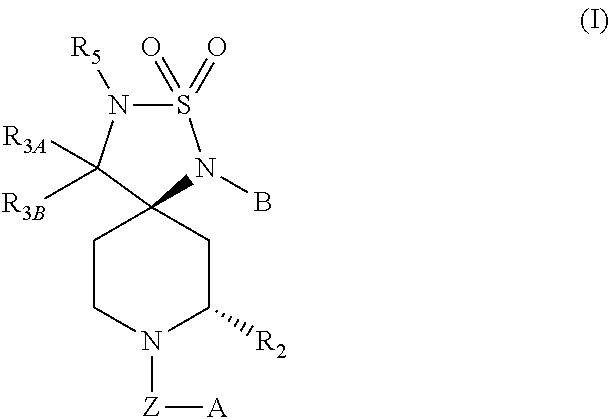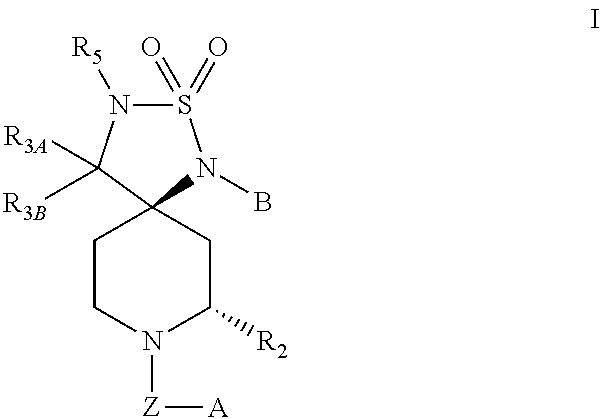Novel Class of Spiro Piperidines for the Treatment of Neurodegenerative Diseases
a neurodegenerative disease and spiro piperidine technology, applied in the field of neurodegenerative diseases, can solve the problems of ineffective treatment for halting, preventing, or reversing the progression of alzheimer's disease, and achieve the effects of improving the stability of pharmaceutical products, improving the effect of drug safety, and improving the stability of drug properties
- Summary
- Abstract
- Description
- Claims
- Application Information
AI Technical Summary
Benefits of technology
Problems solved by technology
Method used
Image
Examples
example 1
(5R,7S)-1-(3-Fluorophenyl)-8-(3-isopropoxybenzyl)-7-methyl-2-thia-1,3,8-triazaspiro[4.5]decane 2,2-dioxide (1a)
[0268]
Benzyl (2S)-4-cyano-4-[(3-fluorophenyl)amino]-2-methyl piperidine-1-carboxylate
[0269]To a solution of benzyl (2S)-2-methyl-4-oxopiperidine-1-carboxylate (see C. Coburn et al., PCT Int. Appl. 2007, WO 2007011810; 20.0 g, 80.9 mmol) in acetic acid (162 mL) was added 3-fluoroaniline (18.0 g, 162 mmol) and zinc cyanide (23.7 g, 202 mmol). The reaction was allowed to stir overnight at room temperature. The reaction was cooled to 0° C. and quenched with ammonium hydroxide until the mixture was basic. The reaction was filtered to provide a yellow solid which was combined with further extractions with methylene chloride, dried with sodium sulfate, and concentrated. The material was purified using silica gel chromatography to afford the title compound (29.7 g, 72%). MS m / z 368.1 (M+1).
Benzyl (2S)-4-(aminomethyl)-4-[(3-fluorophenyl)amino]-2-methylpiperidine-1-carboxylate
[0270]T...
example 2
(5R,7S)-1-(3-Fluorophenyl)-8-(3-isopropoxybenzyl)-3,7-dimethyl-2-thia-1,3,8-triazaspiro[4.5]decane 2,2-dioxide
[0274]A solution of (5R,7S)-1-(3-fluorophenyl)-8-(3-isopropoxybenzyl)-7-methyl-2-thia-1,3,8 triazaspiro[4.5]decane 2,2-dioxide (1a) (20 mg, 0.045 mmol) in DMF was added to a slurry of NaH (3.6 mg, 0.09 mmol) in DMF (0.6 mL) at 0° C. The reaction was stirred at 0° C. for 2 hours then methyl iodide (8.7 mg, 0.061 mmol) in DMF (0.2 mL) was added. The reaction was allowed to gradually warm to room temperature and stirred overnight. The reaction was diluted with water and extracted with ethyl acetate (3×10 mL). The combined organics were dried, concentrated, and purified by silica gel chromatography to yield the title compound (15 mg, 67%). 1H NMR (400 MHz, CHLOROFORM-d) δ ppm 1.04 (d, J=6.64 Hz, 3H) 1.30 (d, J=5.81 Hz, 6H) 1.64 (dd, J=13.69, 4.98 Hz, 1H) 1.89-1.96 (m, 2H) 2.04 (dd, J=13.48, 4.77 Hz, 1H) 2.28-2.37 (m, 1H) 2.49-2.58 (m, 1H) 2.75-2.80 (m, 1H) 2.82 (s, 3H) 3.26 (d, ...
example 3
(5R,7S)-1-(3-fluorophenyl)-8-(3-isopropoxybenzyl)-7-methyl-3-(pyridin-2-ylmethyl)-2-thia-1,3,8-triazaspiro[4.5]decane 2,2-dioxide (3)
[0275]
(5R,7S)-1-(3-Fluorophenyl)-8-(3-isopropoxybenzyl)-7-methyl-2-thia-1,3,8-triazaspiro[4.5]decane 2,2-dioxide (Compound 2; also described as Example 1a)
[0276]A solution of 1-(bromomethyl)-3-isopropoxybenzene (239 mg, 1.04 mmol) in DMF (0.5 mL) was added drop-wise over 5 min to a mixture of (5R,7S)-1-(3-fluorophenyl)-7-methyl-2-thia-1,3,8-triazaspiro[4.5]decane 2,2-dioxide (P2, 312 mg, 1.04 mmol) and cesium carbonate (680 mg, 2.09 mmol) in DMF (3 mL), and the resulting suspension was stirred overnight at room temperature. The reaction mixture was then diluted with water (20 mL) and extracted with ethyl acetate (3×30 mL); the combined organic extracts were dried over sodium sulfate, filtered, and concentrated in vacuo. The residue was purified by silica gel chromatography (Gradient: 0% to 5% MeOH in dichloromethane) to provide the product as a white s...
PUM
| Property | Measurement | Unit |
|---|---|---|
| temperature | aaaaa | aaaaa |
| temperature | aaaaa | aaaaa |
| temperature | aaaaa | aaaaa |
Abstract
Description
Claims
Application Information
 Login to View More
Login to View More - R&D
- Intellectual Property
- Life Sciences
- Materials
- Tech Scout
- Unparalleled Data Quality
- Higher Quality Content
- 60% Fewer Hallucinations
Browse by: Latest US Patents, China's latest patents, Technical Efficacy Thesaurus, Application Domain, Technology Topic, Popular Technical Reports.
© 2025 PatSnap. All rights reserved.Legal|Privacy policy|Modern Slavery Act Transparency Statement|Sitemap|About US| Contact US: help@patsnap.com



